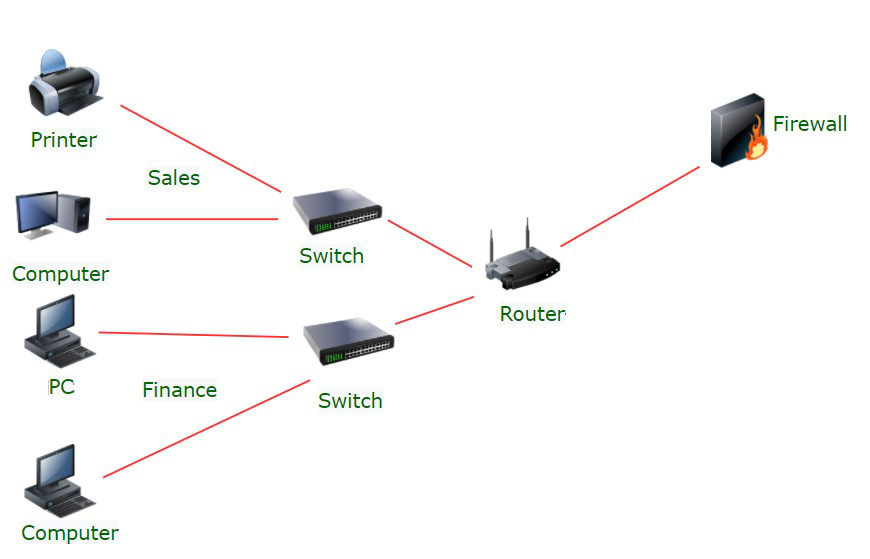What is Network Segmentation?
Last Updated :
16 Apr, 2024
In computer networking, segmentation is an important idea to improve the security and performance of the network. In other words, Network segmentation is the idea of creating subnets within a network or networks within a network. In this article, we are going to discuss network segmentation.
What is Network Segmentation?
Network segmentation in computer networks is defined as the process of dividing a computer network into smaller, isolated segments or subnetworks. Sometimes, network segmentation is also referred to as network isolation or network segregation. Each segment contains a specific group of devices or resources and is separated from other segments by network devices such as routers, switches, or firewalls.
Let’s understand with an example, GeekforGeeks organization has different teams like sales and finance. Both teams have their network, but they cannot access the files on one another’s networks. In case the sales team wishes to access the files of the finance team it will have to pass through a switch, router, and then a firewall. The diagram below is a clear representation of the same.

Network Segmentation in an Organization
What is Network Segmentation Used for?
Network segmentation has several benefits for organizations. It does not have a single purpose, but primarily it is used to organize networks. Segmentation also allows for more efficient use of bandwidth by reducing the size of broadcast domains and getting rid of unnecessary traffic on the network. Another benefit of having a segmented network is that it enhances security by reducing an organization’s attack surface by not keeping all computers in the same network space. When you separate a network, all outbound and inbound traffic has to go through a layer-3 device, a router, and a firewall if there is one. If one team wants to contact another team over a network, the traffic passes through the router and firewall. Thus, segmentation gives a little more control to the organization over the traffic because the firewall can do things like deny unnecessary traffic.
How does Network Segmentation Work?
Network segmentation divides a network into different zones and controls each zone separately. This involves implementing traffic protocols to control what traffic flows through the segment and what is not permitted. It also addresses security protocols for each zone to ensure security and compliance. Network segments are marked with their specialized hardware to separate them and restrict system access to authorized users. Network settings provide rules that govern how subnetwork users, services, and devices interact with one another.
Types of Network Segmentation
1. Physical Segmentation
To physically segment a network, one has to plug different groups of devices into separate switches. Physical segmentation is the most secure choice, but it is also the most difficult to implement. Physical Segmentation is known as perimeter-based segmentation, each section requires its own internet connection, physical wiring, and a firewall. There are limited constraints on internal resources, which typically work over a flat network with minimal internal network partitioning. Physical segmentation is also quite unstable. Once hackers or malicious users have gained access to the firewall, they may move freely around the network with no or little restriction.
2. Virtual Segmentation
Virtual segmentation, also known as logical segmentation, refers to the division of a single physical network into multiple virtual networks or segments. These segments are logically isolated from each other, allowing for distinct communication and security policies to be applied to each segment. Virtual segmentation is often implemented using technologies such as VLANs (Virtual Local Area Networks).
Benefits of Network Segmentation
- Improved Monitoring
- Network Segmentation reduces the complexity of the network.
- Useful for organizing networks
- Allows for more efficient use of bandwidth
- Enhances security and reduces the risk of cyber-attacks
- Improve Operational Performance
How To Implement Network Segmentation?
- Identify The Most Valuable Assets And Data.
- Classify Each Asset With A Label.
- Detect And Create A Map Of The Network And Data Flow.
- Determine How A Company Wants To Segment The Network.
- Deploy A Network Traffic Segmentation Gateway.
- Produce A Company-Wide Access Control Policy.
- Perform Audits, Reviews, And Automate Network.
Difference Between Network Segmentation and Microsegmentation
|
Network Segmentation
|
Microsegmentation
|
|
Network segmentation is defined as the process of dividing a computer network into smaller, isolated segments or subnetworks
|
Further division of network segments into smaller, granular security zones, usually at the workload or application level.
|
|
Network segmentation is generally considered a north-south network traffic control
|
Microsegmentation is generally considered an East-West network traffic control
|
|
Network Segmentation is implemented using VLANs, access control lists (ACLs), and firewall rules.
|
They are implemented using software-defined networking (SDN) technologies and network virtualization platforms.
|
|
Network Segmentation provides isolation between major network segments
|
Microsegmentation provides finer-grained isolation within network segments,
|
Frequently Asked Questions on Network Segmentation – FAQs
Which device provides microsegmentation in a data center network?
Hypervisor Based Microsegmentation.
Why is network segmentation used?
Network segmentation offers unique security services for each network segment, giving you more control over network traffic, optimising network performance, and boosting your safety measures.
What layer is segmentation in?
Segmentation done at Transport Layer of the OSI Model.
Share your thoughts in the comments
Please Login to comment...